Stephanie Seidler is an experienced early educator who is passionate about promoting meaningful educational experiences for children.
She recently created a presentation to help educate teachers and parents about the benefits of process art over product art.
Stephanie has kindly agreed to let us share it with you so that you can prepare educators and families for a “craptivity”-free future.
I spend A LOT of time talking to educators and parents about the value of process over product. And while I feel the process-driven approach is gaining momentum, there is still an alarming number of educators and parents who prefer the product over the outcome.
What are product-driven crafts?
- There are specific steps to follow
- There is an anticipated and specific outcome
- Adults often prepare some or all the materials needed to complete the product
When I ask teachers and parents “why do you feel this (product/craft) is important?” I usually get these three answers:
- Children follow directions
- Children work on fine motor skills
- Children learn where facial features should be placed.
Here’s my dilemma with these three responses:
1. Children following directions
Don’t children have to follow directions all day? e.g. “sit down,” “stand up,” “raise your hand,” “put your hands down,” “line up,” “no talking,” “eat lunch,” “clean up lunch,” find a center,” clean up your center,” etc. A child’s day IS following directions. Their art should be free of such direct guidance.
2. Children work on fine motor skills
Fine motor is incorporated… but to a minor extent. If a child is presented with a mundane task of glueing a couple of pieces of paper on a cutout, we’ve limited their experience. Plus, after the “last eye” is glued on, the project is over. It can only go until the product is completed.
3. Children learn facial features
Teachers often claim these crafts are important to teach “where the eyes go,” or even emphasize that this is how they teach shapes and colours. We need to give children more credit than this. If we’re telling them where to put the “eye” we’re not allowing them to figure out where the eye goes. They’re missing out on the learning.
Children are aware and smart. When they’re interested in creating concrete images, they will problem solve, think critically and do so. This is where teachers can incorporate mirrors, or have children think about where things can be placed, instead of just giving the answer.
It’s our job to inform parents of why the process matters and why adult-led arts and crafts can be detrimental when they are the focus of early learning.
I’ve found this approach really helpful in supporting the parents and teachers to talk about why there is more value in process than product.
The School Bus Project example
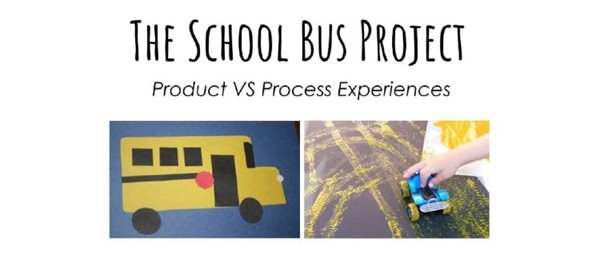
Before I start my presentation, I explain that two different classrooms are learning about transportation, and decide to further explore the topic of school buses:
- Both classrooms read books that showcase school buses
- Both classrooms sing ‘Wheels on the Bus’ and other transport-related songs
Afterwards, they decided to extend their learning through an experience.
Children in both classrooms can easily identify and understand what a bus is.
Class A – take the traditional product-led route by making a school bus
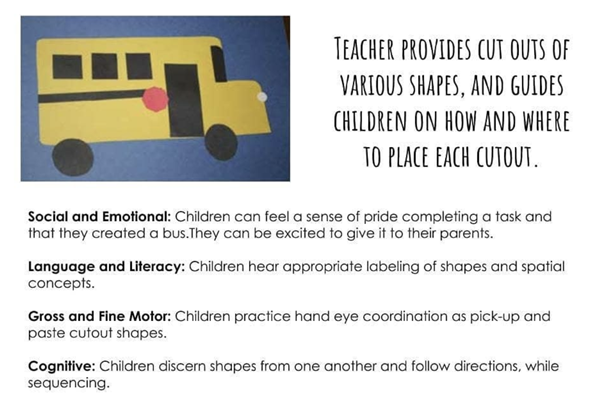
Class B took the progressive route by focusing on process/play

I walk the audience through the process for each and pose the question:
Which activity was most meaningful for the children?
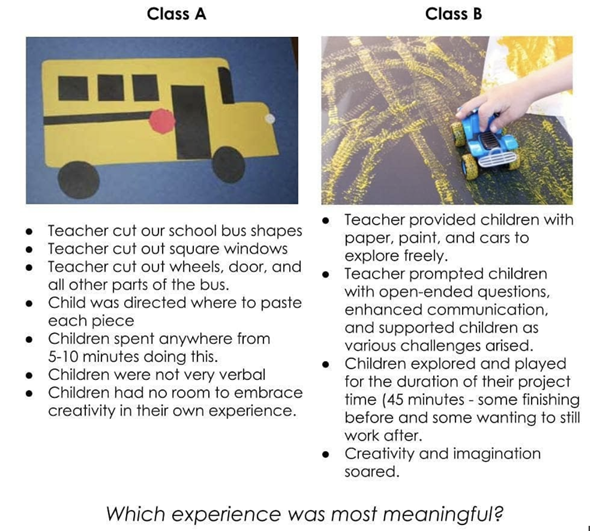
I then ask the audience to reflect on the questions in the following slide:
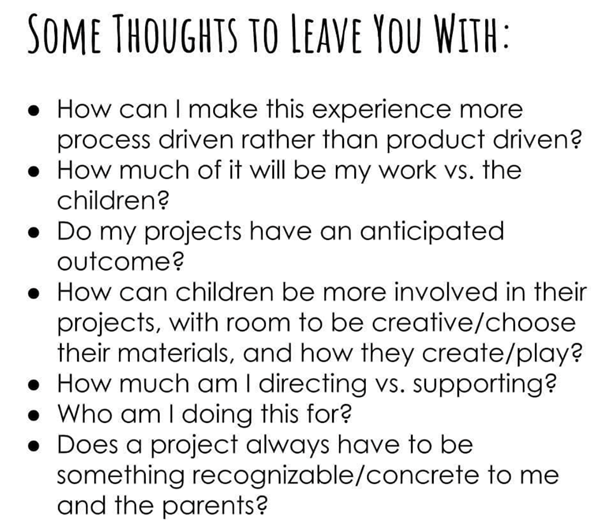
There’s still room for projects with a purpose
I am definitely a fan of process over product, however, I do see the value of a meaningful and well-considered product-driven project.
After all, a (good) product-driven product can teach planning, mapping, problem-solving, evaluating, re-evaluating, altering, rearranging, focus, execution, and fine motor skills.
When we want to facilitate a product-driven project for children, we should ensure the above skills will be fostered, in order for it to be meaningful and educational.
To avoid turning a product-driven project into a “craptivity”, I invite early educators to take some time to reflect the following areas:
- Am I doing more work than the child (cutting, directing, arranging, etc.)?
- Is this project tackling most, if not all domains of development? If not, how can I adjust to broaden the experience?
- Who is this project for? Is it for parents, to display on social media or for the benefit of children’s learning?
- What can I do to add more meaning to this experience (e.g. how can the subject be discussed in greater detail before creating? Can children have more than a day to work on it? Can they revisit and change as need be? Add to t it? How can we expand on the experience?
- Does the experience offer open-ended materials for the children to explore as they see fit?
- Am I “okay” if it doesn’t turn out as anticipated?
- Am I comfortable not using a template, guide, or image to model the project after?
- Am I directing the children OR guiding them (if and when they need support)?
- Can I make the process of learning visible to convey how their experience was meaningful through documentation – helping fellow teachers and parents to better understand the “why?”
I know it can be super uncomfortable to step out of traditional and familiar practices, but if we aren’t challenging ourselves we’re not only doing a disservice to ourselves but the children as well.
Here’s to elevating education! You got this.
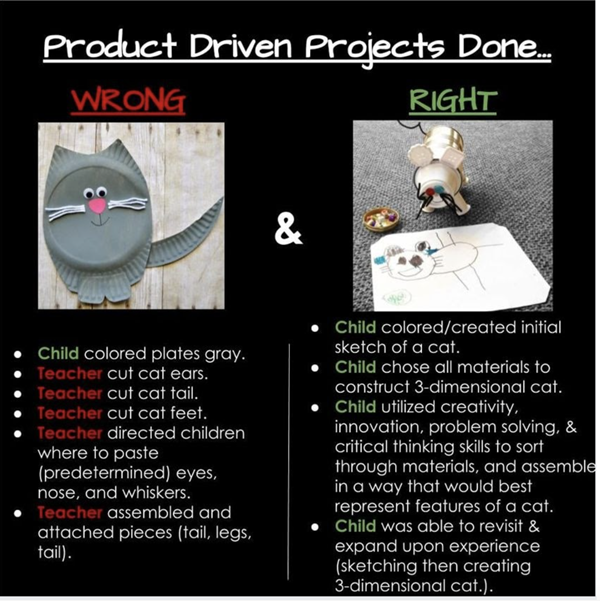
Stephanie Seidler is an experienced childhood educator based in Brooklyn, NY. Over the course of the last decade, she’s worn many professional hats such as Teacher, Director, and Instructional Leader, while also leading professional development sessions and workshops for teachers and parents.
She’s been particularly inspired by the Reggio Emilia philosophy, mainly because of its profound respect for children, viewing them as competent, capable, and worthy enough to be co-constructors in their education.
Follow Stephanie on Facebook.
Save the images from her Facebook post on this topic to use in your own early education service.
Further reading:
Become a CELA Member
CELA provides professional support to navigate the ECEC environment.
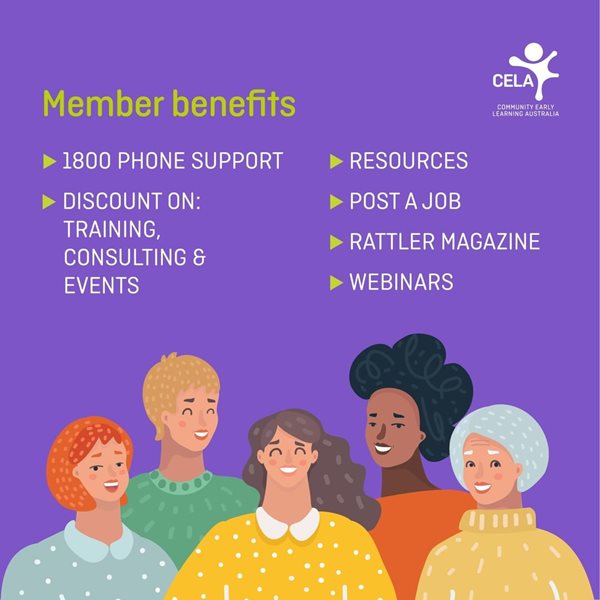
About Stephanie
Stephanie Seidler is an experienced childhood educator and author based in Brooklyn, NY. Over the course of the last decade, she’s worn many professional hats such as Teacher, Director, and Instructional Leader, while also leading professional development sessions and workshops for teachers and parents.
She’s been particularly inspired by the Reggio Emilia philosophy, mainly because of its profound respect for children, viewing them as competent, capable, and worthy enough to be co-constructors in their education.